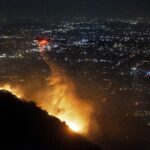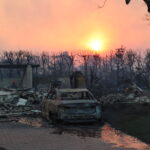Mercury General Corporation said it expects losses from wildfires burning in California since Jan. 7 to exceed its $150 million reinsurance retention, without providing a specific dollar estimate of losses the company expects to incur.
The first publicly traded U.S. insurer to provide any wildfire updates on Jan. 10, the Los Angeles-based carrier, which is focused on home and personal auto insurance, reported that the limit of its reinsurance program, written on a per-occurrence basis, is nearly $1.3 billion.
But are the wildfire events one occurrence for the purposes of reinsurance?
The language of the media statement suggests that Mercury views this as one occurrence.
Answering a general question about typical reinsurance programs, without reference to Mercury General, Taoufik Gharib, a senior director at S&P Global Ratings said he believes that “for wildfire reinsurance coverage, contracts typically include hours clauses (e.g., 7-10 days) and radius restrictions (e.g., 250 miles). If a fire breaks out within the pre-agreed contractual parameters, the peril is considered a single event,” he stated.
On Friday, Cal Fire showed about 36,000 acres burned for five fires, or roughly 56 square miles (according to online calculators). Three of them, the Palisades, Eaton and Hurst fires, started on Jan. 7, while the Lidia and Kenneth fires started on Jan. 8 and 9. (Update: A sixth fire, the Archer Fire, with a Jan. 10 start date, was listed on Saturday, with a Jan. 10 start date.)
Assessing the situation from the reinsurance industry perspective, Gharib noted that the early January timing of the fires will somewhat insulate reinsurers from large claims “because the fires occurred early in the year,” which means that “primary insurers have not yet fully depleted their retentions.” He noted, however, that “this could change depending on the magnitude and the duration of this event.”
Gharib is also one of the authors of an S&P report published last week, “Insurers Can Absorb Losses Amid Escalating Los Angeles Wildfires.” In the report, S&P said that wildfire losses could “rapidly deplete the catastrophe budgets of U.S. primary insurers,” leading to earnings pressure later in the year, but that financial ratings impact would be limited for insurers rated by S&P.
Strong results in 2024 and materially reduced policy coverage offered in California’s wildfire prone areas were reasons supporting the conclusion.
(Editor’s Note: A list of 20 rated insurers with the biggest shares of the California property market included in the report does not include Mercury.)
Related article: Significant But ‘Manageable’ Insurance Losses Expected From LA Fires: S&P
For reinsurers, the S&P report called the event “manageable,” with reinsurance losses expected to be low—within first-quarter 2025 natural catastrophe budgets.
Robert Hartwig, a clinical associate professor of finance and insurance at the University of South Carolina, and head of the university’s Risk and Uncertainty Management Center, told Insurance Journal (Carrier Management’s sister publication) that even though reinsurers have maintained high attachment points in recent years, they will experience an impact from the wildfires, which together are highly concentrated, geographically, and in terms of the time frame. This is “precisely what reinsurance is designed for,” he said.
Weighing in on the one or multiple events question for Carrier Management, Hartwig said the answer is uncertain. “There will need to be an objective analysis of the issue,” he responded in an email.
In California, there’s always the concern—and possibility—that one or more of the fires was ignited by some issue with a utility, while others might start from other causes (lightning, camp fires, etc.), he said, referring to reports that insurers have told Southern California Edison to “preserve evidence” related to ignition issues associated with the utility. (See subhead, “Commercial Liability Insurance” below for discussion of potential liability for utilities and related insurance coverage.)
Related article: Insurers Ask Edison to Preserve Evidence Related to Fire
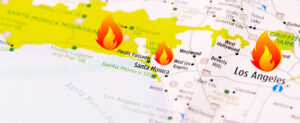 In addition to possibly distinct causes for different fires, Hartwig pointed out that maps of the event appear to show “a good distance between the two major fires.” As a result, “one could then argue that these are two distinct events,” he said. “On the other hand, both began on Jan. 7 and the same dry, windy conditions contributed to the rapid spread of both blazes, which might suggest a singular event.”
In addition to possibly distinct causes for different fires, Hartwig pointed out that maps of the event appear to show “a good distance between the two major fires.” As a result, “one could then argue that these are two distinct events,” he said. “On the other hand, both began on Jan. 7 and the same dry, windy conditions contributed to the rapid spread of both blazes, which might suggest a singular event.”
Hartwig also noted that not all reinsurance programs are written on a per-event basis. For reinsurance written on an aggregate basis, “the distinction of one vs. two (or more) events is less relevant,” he said, noting that “reinsurance could potentially play a larger role during later in 2025 (during the ‘normal’ wildfire season in the fall).”
Bottom line, there no certainty at this point as to whether this will go down as one or multiple events, he said. “It’s a potential question.”
As for Mercury, the company did not respond to Carrier Management’s question about event-counting at press time. But the insurer did disclose in the media statement that its reinsurance program provides coverage for assessments from the California FAIR plan. The statement also noted that if the full $1.29 billion of limit is used up, then the total reinstatement premium would be $101 million.
Update: Mercury General Gives Reinsurance Update: One or Two Events Still TBD
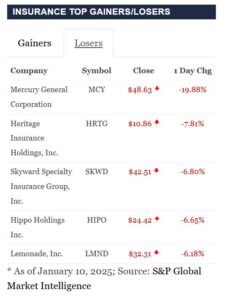
A stock market tracker displayed on the Carrier Management homepage, populated with information from S&P Global Market Intelligence, revealed that Mercury General had the highest percentage drop among insurance stocks on Friday, after the announcement.
Separate reports released by rating agencies and analysts last week put Mercury General high up on lists of insurers exposed to wildfire losses.
Analyst Meyer Shields of Keefe, Bruyette & Woods, listed Mercury Insurance eighth on a list of the top 50 exposed wildfire carriers, using 2023 California direct premiums for fire, allied lines, crop, homeowners, farmowners, inland marine and auto physical damage to represent California wildfire-exposed premium. Mercury’s wildfire-exposed premium was $2.1 billion.
Shields analysis also shows the ratio of California wildfire-exposed premium to consolidated premium for each group with Mercury showing the second highest ratio—45.5 percent. (Only a much smaller California insurer, Pacific Specialty Insurance, had a higher ratio at 85.6 percent.)
In the Jan. 8 research note he shared with Carrier Management, Shields noted that premiums listed for some of the individual carriers might be overstated because the premium data dates back to 2023, Data for the year 2024 is not yet available and many insurers pulled back from the California market in 2024.
Mercury, however, has highlighted its commitment to the market. In May 2024, the company announced that it would accept 12,556 home policies of Tokio Marine America and a subsidiary that planned to exit the California personal lines market. And just last Monday, on the day the fires started in Southern California, Mercury announced it would be the first major insurer to return to the northern town of Paradise, Calif. to write homeowners insurance. Paradise was the site of what was previously the deadliest and most destructive fire in California history—the 2018 Camp Fire. But Mercury pointed to the fact that the town was rebuilt to standards set by the Insurance Institute for Business & Home Safety to strengthen resistance to wildfire embers among factors supporting its decision to return.
Related articles: Mercury Taking Over Tokio Marine California Biz, Bullish on CDI Strategy; Mercury Insurance to Return to Fire-Ravaged Paradise, California
Referencing data from S&P Global Market Intelligence, rating agencies AM Best and Moody’s Ratings both published lists of top homeowners insurers in California ranked by 2023 direct premiums (top 20 for AM Best and top 10 for Moody’s), ranking Mercury as the eighth largest player with $839 million in 2023 direct homeowners premiums. Mercury, however, did not appear on a separate list of carriers that have at least 75 percent of their property portfolios in California in the AM Best report. (Sources: “Expanding California Wildfires Expected to Incur Large Insured Losses,” AM Best, Jan. 9, 2025; “Insurers face large losses from devastating Los Angeles wildfires,” Moody’s Ratings, Jan. 9, 2025)
Mercury also did not appear on a list of 20 rated P/C insurers ranked by California property market share in the S&P Ratings report. Farmers and State Farm topped that list with roughly 13 percent shares.
***
Commercial Liability Insurance
While most insurance and reinsurance news about the wildfires is focused on personal property at risk, S&P published a separate report last week, referencing commercial insurance for public entities that might be exposed to liability claims.
The report, “As Los Angeles Wildfires Burn, Credit Implications For U.S. Public Finance Issuers Are Unclear,” notes the potential negative impact on the credit ratings of public finance issuers, including not-for-profit electric and water and sewer utilities, local governments, and school districts.
One page of the report summarizes some of the liability insurance coverage available for three impacted not-for-profit electric utilities—Los Angeles Department of Water and Power, Burbank Water and Power, and Glendale Water and Power—showing liability insurance limits totaling about $285 million for the three entities combined.
The wildfires pose “significant financial and operational risks for rated entities, especially if not-for-profit electric utilities’ infrastructure triggered the fires,” S&P Global Ratings said in the report.
“In our view, credit risk for not-for-profit electric utilities could result from wildfires due to the potential for significant liabilities,” said S&P Global Ratings Credit Analyst Paul Dyson in a statement.
The report refers to a strict liability “inverse condemnation” doctrine in California courts that allows for a utility to be held liable for wildfire damage whether or not negligence contributed to the fire. “Not-for-profit electric utilities’ overhead power lines and other infrastructure are susceptible to sparking fires during severe weather, particularly wind events.”
The report notes that if it’s ultimately determined that not-for-profit electric utilities contributed to ignition, S&P will assess both the adequacy of balance-sheet liquidity and insurance coverage in its credit rating assessments.
The S&P report did not address any potential liability concerns related to a loss of water pressure to local fire hydrants in Los Angeles and an offline reservoir reported last week and now under scrutiny from public officials. On Friday, California Governor Gavin Newsom sent a letter to the CEO of the Los Angeles Department of Water and Power and the director of LA County Public Works, calling for the entities to prepare a review of response procedures and initiating an independent after-incident report on the causes to be conducted by state water and firefighting officials. (Newsom posted the news on X on Friday.)
The chart summarizing insurance information for selected utilities in the S&P report (along with information on ratings, customers, revenues, outages and other financial information) shows $205.5 million of wildfire liability insurance coverage for LADWP. A chart footnote indicates that LADWP had also been pursuing a catastrophe bond issue of at least $50 million late last year, with an attachment point at $100 million, and that the utility has an additional $232.5 million in a self-insurance fund specific to the power system but not for wildfire losses.




















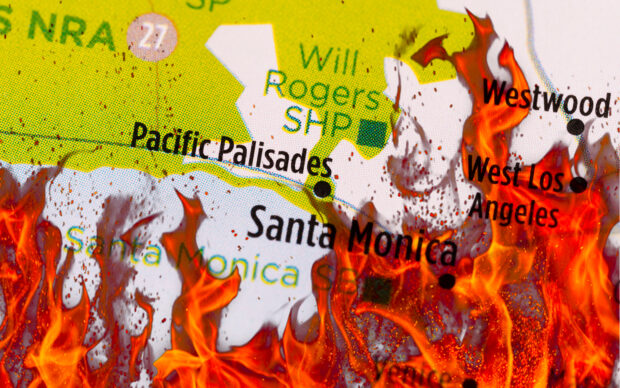
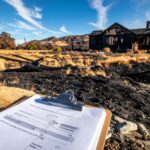 Unpacking a Consumer Intervenor’s Novel Idea
Unpacking a Consumer Intervenor’s Novel Idea  Viewpoint: Mapping Evolving Regulatory Terrain for MGAs, MGUs and Other DUAEs
Viewpoint: Mapping Evolving Regulatory Terrain for MGAs, MGUs and Other DUAEs  Women Are Now Leaning Out in the Workplace
Women Are Now Leaning Out in the Workplace  The Future of Knowledge in Insurance: From Training to AI-Powered Productivity
The Future of Knowledge in Insurance: From Training to AI-Powered Productivity 